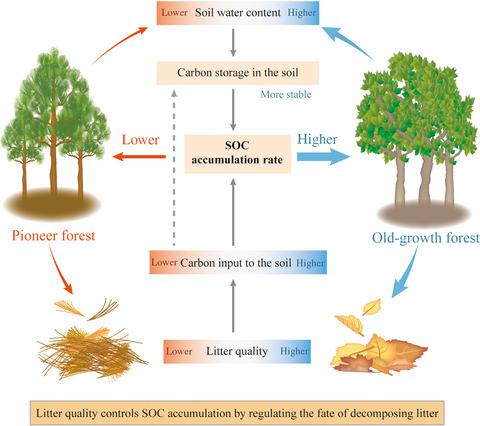当前位置:
X-MOL 学术
›
J. Appl. Ecol.
›
论文详情
Our official English website, www.x-mol.net, welcomes your feedback! (Note: you will need to create a separate account there.)
Soil organic carbon accumulation modes between pioneer and old‐growth forest ecosystems
Journal of Applied Ecology ( IF 5.7 ) Pub Date : 2020-08-19 , DOI: 10.1111/1365-2664.13747 Xin Xiong 1, 2 , Guoyi Zhou 3 , Deqiang Zhang 1, 2
中文翻译:

先锋森林与老龄森林生态系统之间的土壤有机碳积累模式
更新日期:2020-08-19
Journal of Applied Ecology ( IF 5.7 ) Pub Date : 2020-08-19 , DOI: 10.1111/1365-2664.13747 Xin Xiong 1, 2 , Guoyi Zhou 3 , Deqiang Zhang 1, 2
Affiliation

|
- Increasing evidence suggests that high biomass and litterfall do not necessarily bring about soil organic carbon (SOC) sinks, contrary to the assumption that higher litterfall implies higher SOC when designing carbon models. The underlying mechanism is related to the quality of litter.
- We conducted 15 years (2000–2015) of consecutive field measurements of δ13C values in SOC and plants in a pioneer forest (Pinus massoniana forest, PF) and an old‐growth forest (monsoon evergreen broadleaved forest, BF), using an isotope mixing model based on mass balance to quantify the effects of vegetation on SOC stock and soil characteristics.
- The carbon to nitrogen (C/N) ratio of litter in BF was lower than that in PF. The proportion of organic carbon yield input to the soil (Cinput) to the total litter carbon loss during decomposition was 38.7 ± 3.3% and 28.0 ± 2.1% in BF and PF respectively. New carbon input was higher in BF (148.7 ± 8.8 g C m−2 year−1) than PF (99.7 ± 4.5 g C m−2 year−1), though there was a non‐significant difference in annual litterfall between the two forests. Moreover, the Cinput was concentrated in the topsoil layer in PF but distributed in a more dispersed state across the whole soil profile in BF. Consequently, only the δ13C values of SOC decreased in the topsoil layer of PF, whereas these decreased at both soil depths in BF from 2000 to 2015.
- Compared with PF, BF exhibited higher carbon input and a more favourable soil environment for carbon storage. It was the amount of intermediate product (i.e. Cinput) of litter decomposition, not the amount of litterfall itself, that drove the contrasting differences in SOC status.
- Synthesis and applications. Litter quality controls soil organic carbon (SOC) accumulation by regulating the fate of decomposing litter, which may explain why old‐growth forests can sustainably accumulate carbon in soil. This finding questions the carbon models that predict the dependence of SOC accumulation on biomass and litter yield and suggests that litter quality should be valued in future carbon cycling models.
中文翻译:

先锋森林与老龄森林生态系统之间的土壤有机碳积累模式
- 越来越多的证据表明,较高的生物量和凋落物并不一定会导致土壤有机碳(SOC)下沉,这与在设计碳模型时较高的凋落物意味着较高的SOC的假设相反。潜在的机制与垃圾质量有关。
- 我们进行的δ连续实地测量十五年(2000- 2015年)13个在SOC C值和植物的先驱林(马尾松林中,PF)和原生林(季风常绿阔叶林,BF),其使用基于质量平衡的同位素混合模型,以量化植被对SOC储量和土壤特性的影响。
- 高炉中凋落物的碳氮比(C / N)低于PF。在分解过程中,BF和PF的输入土壤的有机碳产量(C输入)占枯枝落叶总碳损失的比例分别为38.7±3.3%和28.0±2.1%。BF(148.7±8.8 g C m -2 year -1)的新碳输入量高于PF(99.7±4.5 g C m -2 year -1)的新碳输入量,尽管两者之间的年度凋落物之间无显着差异森林。此外,碳的输入集中在PF的表土层中,但在BF的整个土壤剖面中以更分散的状态分布。因此,只有δ 13PF的表层土壤SOC的C值下降,而2000年至2015年在高炉的两个土壤深度均下降。
- 与PF相比,BF具有更高的碳输入量和更有利的土壤储碳环境。造成SOC状态差异的原因是凋落物分解的中间产物(即C输入)的数量,而不是凋落物本身的数量。
- 综合与应用。凋落物质量通过调节分解凋落物的命运来控制土壤有机碳(SOC)的积累,这可以解释为什么老龄森林可以可持续地在土壤中积累碳。这一发现对预测SOC累积对生物量和凋落物产量的依赖性的碳模型提出了质疑,并建议在未来的碳循环模型中应重视垃圾质量。



























 京公网安备 11010802027423号
京公网安备 11010802027423号